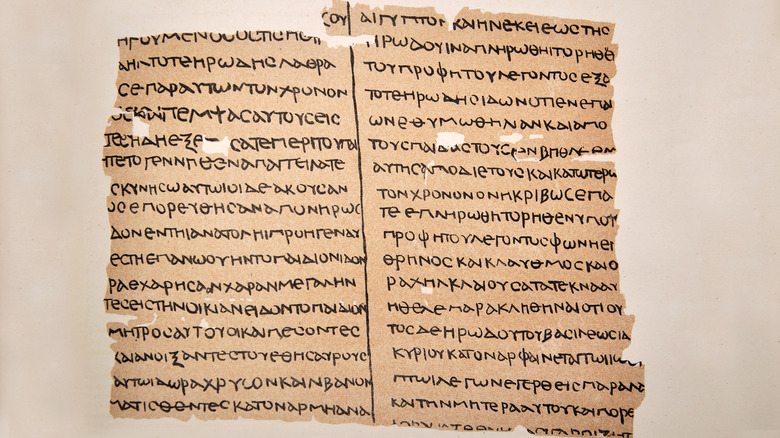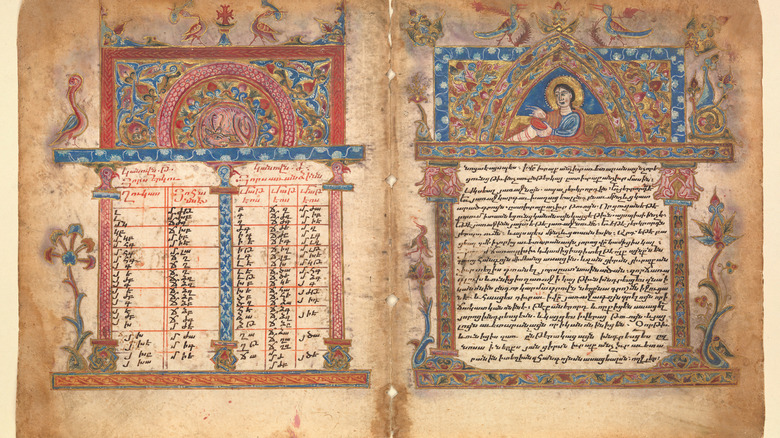The Bizarre Ending Of The Gospel Of Mark Explained
In the Christian Bible's New Testament, the four gospels tell pretty much the same story, which makes the differences between them that much more intriguing. The Gospel of Mark in particular is famous for being very short — the story cuts out at the end before Jesus ascends to heaven, which seems like a pretty drastic omission.
Instead, Mary Magdelene and the other mourning women simply approach Jesus' tomb to discover the stone has rolled away. A figure in white tells them that Jesus has risen, and they scatter in alarm. End scene. Compare this to the Gospel of Luke, 24: 50-53, which ends, "When he had led them out to the vicinity of Bethany, he lifted up his hands and blessed them. While he was blessing them, he left them and was taken up into heaven. Then they worshiped him and returned to Jerusalem with great joy. And they stayed continually at the temple, praising God."
Depending on which version of the Bible you've read, you may not have noticed this difference — some copies, including the King James Version, have an extra section to fill the gap. There are four different possible endings to the text, which have come down from antiquity in different copies, but the earliest versions of Mark 16 do not include verses 9 through 20. Today it is generally acknowledged that the endings were added later to make up for the abruptness of the text. So why is Mark's story so short?
An accidental end?
Some scholars argue the jarring end to the Gospel of Mark is enough evidence to prove that the text was not supposed to finish where it does. For whatever reason, it is possible the writer just never completed the book. He may have died or simply been interrupted, leaving the gospel unpolished for posterity. Alternatively, some careless person may have damaged the original document. The last page of the fragile papyrus could have been ripped and then discarded, forcing later scribes to concoct a plausible summation of whatever he originally said.
Per Robert Oliver Kevin in the Journal of Biblical Literature, those who make this argument often point out that the original text ends with the word γαρ (gar), which means "for" or "because" in Greek. The effect is that the last bit of text reads, "They were afraid for — " as if the author had broken off mid-sentence. On the other hand, while it may not be stellar Greek, scholar Robert H. Stein points out in the Bulletin for Biblical Research that many historians have demonstrated that other ancient writers often ended their sentences in the exact same fashion — including the writer of the Gospel of John.
... or a deliberate choice?
There is another simpler argument to be made that the writer of Mark cut the story short on purpose. If this is the case then it may have been a stylistic or theological choice. Readers should note that Mark's gospel is probably the oldest of the four texts and does not include the virgin birth, as noted by the Biblical Archaeology Society. Today, we cannot know what the writer actually believed about Jesus Christ or Christianity as a whole. It is possible that Christians at this point in time did not actually believe that Jesus met with the disciples after he had risen. Those stories could have come later — along with stories about the virgin birth.
Alternatively, Mark's short ending may have simply been for dramatic effect. Many scholars nowadays acknowledge that Mark was influenced by the conventions of ancient literature. It has been argued that Mark took inspiration from the epic poet Homer, for example, while others have noted that the structure of his gospel has significant parallels with Greek tragedy. The slightly ambiguous end is dramatic and leaves room for the reader to reflect on the story's message — rather than neatly tying the whole thing up with a happy ending. From a literary point of view, this ending is in some ways more satisfying, giving us pause to consider the mystery of Jesus' life.
Is the longer ending actually the right one?
Today, probably the most controversial take on this topic is the argument that one of the longer endings to the text should be treated as the original. Writing for the Text & Canon Institute, Pastor James Snapp makes a robust defense of the longer ending. Snapp points out that there are 1,653 extant Greek copies of the New Testament that contain verses 9 to 20, eight with a different shorter ending, and only three contain the most commonly accepted shortest ending. Among other arguments, he mentions that although two of the three shortest texts are very old, several Church Fathers whose work is even older — including Irenaeus and Justin Martyr — make reference to the missing material.
A rebuttal to Snapp's argument was also published in Text & Canon, written by New Testament scholar Peter Head. Head responded that the stylistic differences in the longer ending and the evidence from two early Church Fathers — Eusebius and Jerome — provide enough support to the argument that the long versions are later additions. Eusebius in particular commented that in his time (the 3rd to 4th century A.D.), most copies of Mark did not have verses 9-20.



